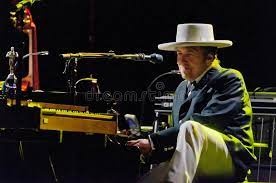
In the next verse beginning with “I can see the history of the whole human race
It’s all right there – it’s carved into your face", God seems to be the subject. We see things here from God’s perspective and these words can therefore best be interpreted as a divine summarization and appreciation of the end result of the- fruitless- efforts from the antagonist to “bring someone to life” and by doing so “make his own version” of God.
The history of the human race is marked by these continuous efforts. “It’s carved into your face” may be an allusion to the Second Commandment: ”You shall not make for yourself a carved image” (Ex. 20:4 NKJV). Throughout history mankind has defied this Commandment and has kept on trying to carve an own version of God. This hideous self-carved image, which is visible in the face of the antagonist, is exactly the opposite of how God meant it to be when He created Man in His own image (Gen1:26).
There was a moment in the history of the human race when God was on the brink of giving up on mankind. Because of the wickedness of man.(Gen.6:5) God repented that He had made mankind. It grieved God at his heart and He was about to destroy mankind (Gen. 6:6,7) and it was as if God asked Himself: “Should I break it all down”? But He did not because Noah found grace in His eyes (Gen 6:8). There was also a time when it was as if God wondered: “Should I fall on my knees“ to save mankind?. He actually did fall on his knees this when Jesus fell on his face in the garden of Gethsemane (Matt.26:39) – “crawling down the avenue” of Getsemane as Dylan calls it in his song “Make you feel my love”- Jesus praying in great anguish and begging His Father: “let this cup pass from me”. It was a time of great darkness on the Cross (Mat.27:45) and when forsaken by God and men, Jesus could have desperately wondered: “Is there light at the end of the tunnel - can you tell me please”.
What now follows may be seen as a sort of reproach from God -Jesus- to the antagonist. The antagonist tries to make his own version of God and of history. It is now as if Jesus says to the antagonist: “For me there was light at the end of the tunnel when I was resurrected from the dead, when I went from suffering to glory, enabling me to set many free and bring them from human bondage and slavery to freedom. But what about you? Look what happens when you, the antagonist is at the steering wheel. “Stand over there by the Cypress tree” and I will show you two examples from history which will show that your way of handling things has produced nothing but slavery”.
The first example of “slavery” takes us to the Mediterranean where the “Cypress tree” grows, it takes us way back to the Trojan War, to “Where the Trojan women and children were sold into slavery”. "The Trojan Women” is a reference to a tragedy by the Greek playwright Euripides, produced in 415 BC during the Peloponnesian War. Wikipedia says that “it is often considered a commentary on the capture of the Aegean island of Melos and the subsequent slaughter and subjugation of its populace by the Athenians earlier that year”.
Now this example of the“Trojan women and children sold into slavery” from Greek history seems to be taken at random but we feel that this is not the case. Dylan writes about the ancient history of Greece and Rome as a sort of model for what happens in our modern times. Apart from “The Trojan women” the words “Long ago before the First Crusade” (1096-1099) and “Way back before England or America were made” also seem to make this connection. This whole idea had already been on Dylan’s mind for at least three decades. Consider what Dylan said in an interview with Paul Zollo in 1991: “A college professor told me that if you read about Greece in the history books, you’ll know all about America. Nothing that happens will puzzle you ever again. You read the history of Ancient Greece and when the Romans came in, and nothing will ever bother you about America again. You’ll see what America". In other words: The Enlightenment, the abolishment of slavery, the industrial and sexual revolution did not make America free, human bondage and slavery in all sorts of ways is still out there in our modern society.
The second example of human bondage and slavery takes us right into hell: ”Step right into the burning hell”. It is called the place “where some of the best known enemies of mankind dwell”. Now it looks as if the following words “Mister Freud with his dreams and Mister Marx with his axe” picture Sigmund Freud and Karl Marx as being inhabitants of hell. This idea seems obvious because both Sigmund Freud and Karl Marx are known as uncompromising atheists. In his book “The Future of an Illusion” Freud describes belief in God as a collective neurosis and called this phenomenon a “longing for a father”.
It is interesting what The Rev. Gianbattista Mondin, S.X. wrote about Karl Marx in an article called “The Atheism of Karl Marx” (taken from: ”L'Osservatore Romano” Weekly Edition in English 20 April 1978, page 12): “Marx is an atheist because of his passion for man. What he wishes to safeguard with atheism is the greatness of man. With atheism he intends to exclude that there is any superior being, greater than man. It is in view of man's greatness that he considers it necessary to destroy religion, because in his judgment the latter is the opium, the drug, the substitute which prevents man from becoming aware of his dignity”. There is similarity between the worldview of Marx proclaiming the superiority of man above God, and Victor Frankenstein, who in his own way, by creating a monster, attempted to be like God and even outdo God.
However, no matter how compelling the picture of Freud and Marx as hell dwellers may be here, yet this is not exactly what the words say. The words do not explicitly state that Freud and Marx are in hell. It seems that this idea is deliberately left unsaid. When you consider that it does not belong to the authority of mortal human beings to condemn anybody to hell- no matter how much you may abhor somebody’s views and walk of life- then you may understand the hesitation in the words of the poet to be too explicit about the whereabouts of Freud and Marx.
But there may be an additional reason to think in another direction. The attributes of hell are usually metaphorically described as fire and brimstone but that is not the case here. This is because this “raw hide lash” in “See the raw hide lash rip the skin off their backs” alludes to an attribute that can be used by a slave-driver. Here it seems as if the subject of slavery still is on the poet’s mind. Slave- drivers may use a “raw hide lash” to punish slaves for either refusing to work or for attempting to escape. Slavery was born the moment man freed himself from God and enslaved himself to Satan.
Slavery was there in ancient times when “ Trojan women and children were sold into slavery”. Slavery is still there in our modern times. Marx promised the proletariat a political state free of religion but this freedom ended up in death and destruction and the utmost slavery for many millions of people in the Gulag. Freud may be debunked here because he defied God in the most intricate of God’s creation: the human mind. The human mind which was made according to God’s own image. Freud played with fire in his attempt to explain the human mind through science rather than through divinity. Here it seems as if the ideas of Freud and Marx to get rid of God and to “make their own version” of God, have come back to haunt them. The same ”raw hide lash” which enslaved their followers and “ripped the skin off their backs” now lashes down on the backs of Freud and Marx.
“You got the right spirit - you can feel it you can hear it- you got what they call the immortal spirit, you can feel it all night you can feel it in the morn, creeps into your body the day you are born” echoes the Romantic poet William Wordsworth (1770-1850). In “Dust as we are, the immortal spirit grows” (from The Prelude, Book 1) William Wordsworth writes:
“Dust as we are, the immortal spirit grows
Like harmony in music; there is a dark
Inscrutable workmanship that reconciles
Discordant elements, makes them cling together
in one society”.
The word “Spirit” rhymes with “you can feel it, you can hear it” and is borrowed from Dylan’s own song “Solid Rock” from the album “Saved” (1981): “It's the ways of the flesh to war against the Spirit, Twenty-four hours a day, you can feel it and you can hear it”. However, whereas in “Solid Rock” there is dualism between the human existence – “the ways of the flesh” and the “Spirit”, this is not the case when you read Wordsworth. “The immortal spirit” suggests that the human spirit or soul is pre-existent and “creeps into your body the day you are born”. For Wordsworth believed that upon being born, human beings move from a perfect ideal realm into an imperfect, vulnerable and sometimes even hostile world. In poems such as the ”Ode: “Intimations of Immortality from Recollections of Early Childhood” (1804) Wordsworth writes:
“Our birth is but a sleep and a forgetting:
The Soul that rises with us, our life's Star
Hath had elsewhere its setting,
And cometh from afar:
Not in entire forgetfulness,
And not in utter nakedness,
But trailing clouds of glory do we come
From God, who is our home:
Heaven lies about us in our infancy!”.
In this song, the idea behind “You got the right spirit” and “you got what they call the immortal spirit” can only thrive in a non-dualistic concept. In this non-dualistic concept the Spirit is not at war against “the ways of the flesh”, the human existence, but is in unity with it. And it is within this unity that the antagonist operates. The antagonist (falsely) claims exclusive ownership of “the immortal spirit " and this ownership is emphasized by the “You” in “You got the right spirit”. Whereas in the dualistic (Biblical) concept the Spirit is a divine gift from heaven, in the non-dualistic concept the spirit is “owned” by the antagonist and “creeps into your body the day you are born”, with all devastating consequences as a result of this. However, no matter the claim of the antagonist that he has the “immortal spirit”, yet the ability “to bring someone to life” is exclusively the territory of the Holy Spirit.
The following lines “One strike of lightning is all that I need, and a blast of electricity that runs at top speed” are once again inspired by Shelly’s novel “Frankenstein”. Victor Frankenstein at the age of 15, witnesses an electrical storm that arouses his interest in electricity and possible applications for its use. In the novel it is assumed that Victor uses this knowledge of electricity to create his monster.
Within the song the creative attempts from the antagonist “to bring someone to life” now reach a climax. Using electricity as a substitute for the spirit represents an ultimate attempt to “jump start his creation to life”, and this is the best he can come up with. Previous attempts like “getting blood from a cactus and making gunpowder from ice” seemed a rather plastic attempt to create life. Here he gets as close as he can be in reaching his goal because he seems to realize that not only he needs some invisible power like an“ immortal spirit”, but also some dramatic instant action like a“strike of lightning” and “a blast of electricity” to “jump start his creation to life”.
In this ultimate attempt he tries to imitate God who creates everything instantly, as in a flash, just at the command of His word, like we said earlier: “For He spoke, and it was done; He commanded, and it stood fast”(Psalm 33:9 NKJV). God does all dramatic, decisive, and life changing acts in the twinkling of an eye, as in a flash of lightning. This will also be the case when He (Jesus) will return to the earth on the clouds: “For as the lightning comes from the east and flashes to the west, so also will the coming of the Son of Man be” (Matt. 24:27 NKJV). Likewise, upon His return, Jesus will not only “bring someone to life”, but He will bring all to life and he will do this in the twinkling of an eye, like it says in 1 Corinthians 15:52 (NKJV): ).”In a moment, in the twinkling of an eye, at the last trumpet. For the trumpet will sound, and the dead will be raised incorruptible, and we shall be changed”.
We already saw that “What would Julius Caesar do?” is a -rough and rowdy- parody of “what would Jesus do?”. Likewise “Show me your ribs - I’ll stick in the knife” is no less a dark parody of God’s initial creation. The poet Milton uses parody in “Paradise Lost” in which Satan mocks God’s creation and Christian rituals.
Consider the gracious and gentle way in which God created Eve: “And the LORD God caused a deep sleep to fall on Adam, and he slept; and He took one of his ribs, and closed up the flesh in its place. Then the rib which the LORD God had taken from man He made into a woman, and He brought her to the man". (Gen. 2:21,22 NJKV)and compare this with the cruel – rough and rowdy – ways of the antagonist: “Show me your ribs - I’ll stick in the knife”.
"I’m gonna jump start my creation to life” sounds triumphant and determined but cannot conceal the futility of this attempt simply because when e.g. you try to jumpstart the engine of your car, you need the help of another car to jumpstart your engine. The antagonist has a problem. To achieve his goal he needs the help of somebody else and he does not have the (divine) tools at his disposal to jumpstart his creation to life.
For the last time we hear “I want to bring someone to life” but now the antagonist seems to realize that “to bring someone to life”, he needs to be in command of time and space so that he can “turn back the years”. Only God is in command of time, just like it says in 2 Peter 3:8 “Do not forget this one thing, that with the Lord one day is as a thousand years, and a thousand years as one day”(NJKV).
Just like for the devil,It is clear that the antagonist is running out of time. He cannot reach perfection. The desire to be able “turn back the years” is only wishful thinking. Wishful thinking, just like it says in Dylan’s song “Shelter from the Storm”: “If I could only turn back the clock to when God and her were born”. Wishful thinking, even if you “do it with laughter – do it with tears”. As a last resort the antagonist turns to the two extremities of human emotion: laughter and tears, but in vain. His laughter is no more than what he wrote in his song "What Good am I?":“laughter in the face of what sorrow brings”! It was Shakespeare’s who wrote in his play “Julius Caesar”: “If You Have Tears, Prepare To Shed Them Now".
The end of the story is that the antagonist now"hits the wall" harder than ever before and in a "rough and rowdy way" at that. For the antagonist and "for all those that sail with him" we may draw the same conclusion as Dylan once did in his song "The Lonesome Death of Hattie Carroll": “Now is the time for your tears”.
Be the first to respond to this article.......






![bob_dylan_london_6[1].jpg bob_dylan_london_6[1].jpg](/media/Image/thumbs/9942bobdylanlondon61.jpg)
